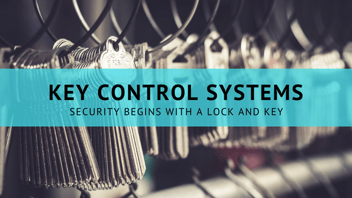Maximizing ROI: Comparing Mechanical vs. Electronic Access Control Systems
 When a business chooses an access control solution, the decision extends far beyond simply buying hardware. It’s an investment, and evaluating the return on investment (ROI) is critical for long-term operational success and security.
When a business chooses an access control solution, the decision extends far beyond simply buying hardware. It’s an investment, and evaluating the return on investment (ROI) is critical for long-term operational success and security.
Access control is broken into two categories – mechanical and electronic. Mechanical key control systems, such as traditional locks, interchangeable cores (IC), and advanced user-rekeyable cylinders, rely on physical keys and hardware. Electronic control systems, like smart locks, keycards, fobs, access panels, and biometric scanners, are mostly dependent upon electricity, connectivity, and software. Although both systems offer distinct benefits, the correct choice to maximize ROI depends entirely on your specific operational needs, scalability requirements, and long-term cost control priorities.
Understanding Mechanical Key Control Systems
Mechanical systems use physical locks and keys to manage access and are characterized by their reliability and simplicity. Advanced mechanical solutions, particularly those utilizing interchangeable cores and user-rekeyable technology, offer significant advantages over standard locks:
- No Reliance on Electricity or Connectivity: They operate reliably regardless of power outages or network failures.
- Fast, Affordable Rekeying: User-rekeyable systems allow on-site personnel to perform a rekey using a simple change key, eliminating expensive locksmith fees and service calls.
- Restricted/Serialized Keys: Manufacturing control ensures keys cannot be duplicated outside of authorized channels, reducing key accountability issues.
Mechanical systems are often the superior choice for environments with high employee turnover, such as retail, quick-service restaurants, and logistics facilities, where rapid, high-volume rekeying is a major cost factor.
Understanding Electronic Access Control Systems
Electronic control systems offer a powerful suite of features centered on digital management. These systems, which may use keypads, card readers, fobs, or mobile credentials, are typically linked to a cloud-based, RFID, or local software platform. Their key benefits include:
- Real-Time Access Logs: Detailed records of entry attempts provide immediate audit trails.
- Remote Management: Access can be granted, revoked, or scheduled instantly from a central control point.
- Integration: They often integrate seamlessly with other security systems like alarms, video surveillance, and HR platforms.
Electronic control systems are most commonly used in environments requiring intricate access permissions and robust reporting, such as corporate offices, data centers, and high-security zones where real-time, granular control is essential.
ROI Drivers to Consider
To conduct a proper ROI analysis, it’s important to account for a wide range of drivers, including response times, scalability, risk mitigation, ease of use, training, upfront financial investment, management of program, and ongoing maintenance requirements.
Speed of Rekeying & Response Time
A mechanical key control system with user-rekeyable cores provides an almost immediate response to a lost key by utilizing the designated change key.
Scalability
Mechanical key control systems based on standardized IC cores can scale efficiently across hundreds or thousands of sites with consistent processes. Electronic control systems require continuous investment in licenses, network capacity, and software support at every new location.
Risk Mitigation
Both control systems reduce risk but target different threats. Mechanical key control systems excel at preventing physical key compromise and unauthorized key duplication. Electronic control systems are better at managing digital access credentials and providing instant audit trails.
User Training & Complexity
Mechanical key control requires minimal training, as the key management procedures are straightforward. Whereas electronic control systems require more training for both platform administration and end-users, especially in multi-site operations, where maintaining consistency and management is complex.
Upfront Costs
Mechanical key control systems offer a lower upfront investment, with minimal complexity for setup. Meanwhile, electronic control systems require IT infrastructure integrations, software licenses, and increased hardware costs.
Ongoing Maintenance
Maintenance for mechanical key control systems is pretty simple. Locks will continue to function as designed as long as they are cleaned and inspected regularly. Electronic control systems can be a bit more complex, incurring software updates or subscription costs, regular battery replacements, technical support staff oversight, and potentially specialized repairs.
Choosing the Right System for Your Business
The decision between mechanical key control and electronic access control should be driven by your risk profile, operational budget, and the daily reality of your business flow. For organizations with distributed sites, high turnover, and a need for simple, immediate security restoration, advanced mechanical solutions like InstaKey’s user-rekeyable interchangeable cores often offer the best blend of security, efficiency, and ROI.
By eliminating locksmith fees and service delays, you convert a major operational expense into a streamlined internal procedure. If you’re looking to find the perfect balance between superior key control and maximized long-term ROI, the best first step is to consult with an expert.



